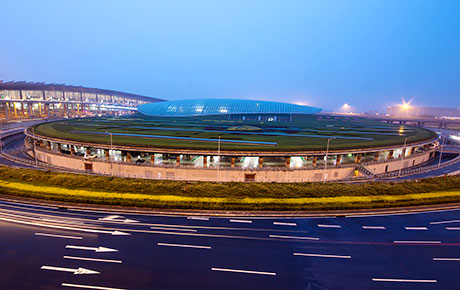
Power supply network automation system of a large international airport
The airport power supply network automation system is designed and implemented in compliance with the design standards and relevant norms of the power plant electrical power monitoring system. The following seven systems are implemented as designed:
First, SCADA monitoring system of the main monitor station
Second, Network communication system
Third, Protection management system
Fourth, WEB HMI system
Fifth, Network tele-video system
Sixth, Big screen display system
Seventh, Electrical energy management system
The airport power supply network automation system is of hierarchical design, composing of main control sections, communication section, and electrical partition (existing equipment). The data signal shall be transmitted through (A# ring, B# ring, and C# ring) gigabit (1G) optical ring network and 11 hundred-megabyte optical ring networks. The communication between the sub-site and the substation also employs an optical network to achieve monitoring to the whole system.
The engineering work includes 110kV transformer substation and all the distribution systems in connection with the outgoing lines, and the monitoring system of the substation located in the jurisdiction of the terminal. The specific stations include:
Comprehensive automatic monitoring system station (placed in the central control room of the 110kV transformer substation)
There are all together 84 transformer substations within this system
(1) T3A switching station and the affiliated 21 transformer house sub-sites; the T3A switching station is 6-circuit incoming lines, respectively from the two transformers of the newly-built 110KV central transformer substation at the airport. The bus couple of this phase is 3-loop and the outgoing line is 54-loop. This station supplies power to the 27 transformer substations within the area. The substations are all dual-circuit supply, with an attended design of switching stations.
(2) T3B switching station and the affiliated 17 transformer house sub-sites; the T3B switching station is 8-circuit incoming lines, respectively from the two transformers of the newly-built 110KV central transformer substation at the airport. The bus couple of this phase is 4-loop and the outgoing line is 42-loop. This station supplies power to the 21 transformer substations within the area. The substations are all dual-circuit supply, with an attended design of switching stations.
(3) T3C switching station and the affiliated 4 transformer house sub-sites; the switching station is an attended design.
(4) GTC switching station and the affiliated 3 transformer house sub-sites; the GTC switching station is 2-circuit incoming lines, respectively from the two transformers of the newly-built 110KV central transformer substation at the airport. The bus couple of this phase is 1-loop and the outgoing line is 12-loop. This station supplies power to the 6 transformer substations within the area. The substations are all dual-circuit supply, with an unattended design of switching stations.
(5) 4# switching station and the affiliated 4 transformer house sub-sites; the 4# switching station is 2-circuit incoming lines, respectively from the two transformers of the newly-built 110KV central transformer substation at the airport. The outgoing line is 12-loop. This station supplies power to the 4 transformer substations within the area. The substations are all dual-circuit supply, with an unattended design of switching stations.
(6) 5# switching station and the affiliated 6 transformer house sub-sites; the 5# switching station is 4-circuit incoming lines, respectively from the two transformers of the newly-built 110KV central transformer substation at the airport. The bus couple of this phase is 16-loop. This station supplies power to the 6 transformer substations within the area. The substations are all dual-circuit supply, with an unattended design of switching stations.
(7) 6# switching station and the affiliated 7 transformer house sub-sites; the 6# switching station is 4-circuit incoming lines, respectively from the two transformers of the newly-built 110KV central transformer substation at the airport. The bus couple of this phase is 24-loop. This station supplies power to the 7 transformer substations within the area. The substations are all dual-circuit supply, with an unattended design of switching stations.
(8) T1 terminal 4 transformer house sub-sites; the switching station is an unattended design.
(9) 1 energy center transformer house sub-site; this station is an unattended design of switching stations.
(10) 1 water supply transformer house sub-site. this station is an unattended design of switching stations.
(11) 1 south light transformer house sub-site; this station is an unattended design of switching stations.
(12) 1 north light transformer house sub-site; this station is an unattended design of switching stations.
(13) 1 auxiliary tower transformer house sub-site; this station is an unattended design of switching stations.
(14) 1 special building transformer house sub-site; this station is an unattended design of switching stations.
(15) 35kV station, power supply station, refrigeration plant, 2# building switching station, and capital airport 110kV station; this said stations are an unattended design of switching stations.
T3A, T3B, T3C, GTC, 4#, 5#, 6#, and T1 terminal transformer substations are with multiple affiliated sub-sites. All information related to the quantity of the state and remote metering of each switching station and its sub-site shall be uploaded to the monitoring system. T3A, T3B, and T3C transformer substations are attended substations. Apart from the data collection front-end processor, local monitoring main machine shall also be installed to realize monitoring over the substation and the sub-sites under the jurisdiction. The overall design shall secure the networking of each switching station and the SCADA system of the affiliated sub-site, and upload the real-time date to the corresponding switching station. Then proceed networking of SCADA systems of each switching station and perform centralized monitoring to the sub-site data, and finally forward the data to the general monitoring station through the trunk gigabyte (1GB) optical network (A# ring, B# ring, and C# ring).









